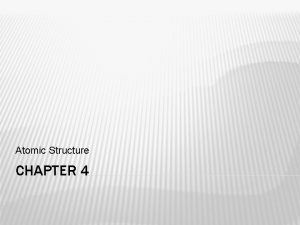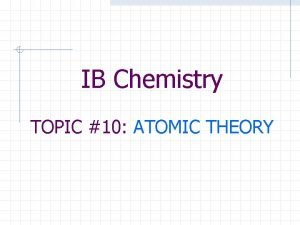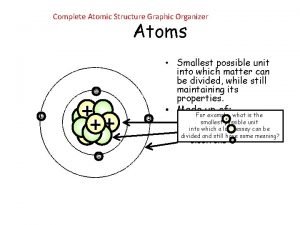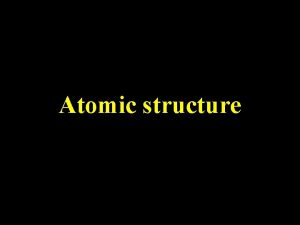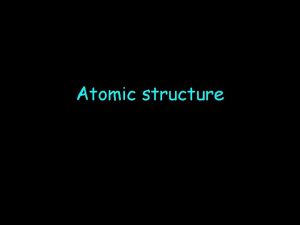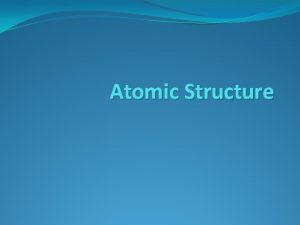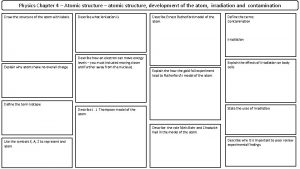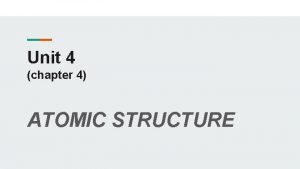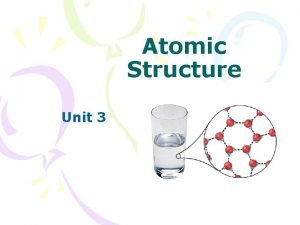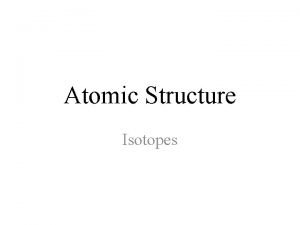Chapter 4 Atomic Structure How Small is the

















- Slides: 17

Chapter 4 Atomic Structure How Small is the Atom?

Section 1 Studying Atoms • Key Concepts • What was Dalton’s theory of the structure of matter? • What contributions did Thomson and Rutherford make to the development of atomic theory?

Ancient Greek Models of Atoms • The philosopher Democritus believed that all matter consisted of extremely small particles that could not be divided. • He called these particles atoms from the Greek word atomos, which means “uncut” or “indivisible. ”

Ancient Greek Models of Atoms • Aristotle did not think there was a limit to the number of times matter could be divided. • Aristotle thought that all substances were built up from only four elements—earth, air, fire, and water

Ancient Greek Models of Atoms • Which Philosopher was correct: Democritus or Aristotle? • For many centuries, most people accepted Aristotle’s views on the structure of matter. • BUT • Democritus would be proven correct by:

John Dalton’s Atomic Theory • Dalton studied the behavior of gases in air. • Dalton developed a theory to explain why the elements in a compound always join in the same way. • Dalton proposed theory that all matter is made up of individual particles called atoms, which cannot be divided.

Dalton’s Atomic Theory • All elements are composed of atoms. • All atoms of the same element have the same mass, and atoms of different elements have different masses. • Compounds contain atoms of more than one element. • In a particular compound, atoms of different elements always combine in the same way.

Thomson’s Model of the Atom • When some materials are rubbed, they gain the ability to attract or repel other materials. • Joseph John Thomson (1856– 1940), better known as J. J. Thomson, used an electric current to learn more about atoms. • Thomson’s experiments provided the first evidence that atoms are made of even smaller particles. • He discovered the Electron. • Electron – Negatively charged particle found in the atom

Thomson’s Model • In Thomson’s model of the atom, the negative charges were evenly scattered throughout an atom filled with a positively charged mass of matter. • The model is called the “plum pudding” model, after a traditional English dessert. A scoop of chocolate chip ice cream can represent Thomson’s model of the atom.

Rutherford’s Atomic Theory • In 1899, Ernest Rutherford discovered that uranium emits fast-moving particles that have a positive charge. • He named them alpha particles • what happens to alpha particles when they pass through a thin sheet of gold.

Rutherford’s Hypothesis • hypothesized that the mass and charge at any location in the gold would be too small to change the path of an alpha particle. • He predicted that most particles would travel in a straight path from their source to a screen that lit up when struck.

The Gold Foil Experiment • More particles were deflected than he expected. • Some of the alpha particles behaved as though they had struck an object and bounced straight back.

Discovery of the Nucleus • Rutherford concluded that the positive charge of an atom is not evenly spread throughout the atom. • It is concentrated in a very small, central area that Rutherford called the nucleus • The nucleus is a dense, positively charged mass located in the center of the atom.

Rutherford’s Atomic Theory • According to Rutherford’s model, all of an atom’s positive charge is concentrated in its nucleus. • Rutherford also discovered the Proton • Proton – positively charged particle located in the nucleus

Reviewing Concepts • 1. What theory did Dalton propose about the structure of matter? • 2. What evidence did J. J. Thomson provide about the structure of an atom? • 3. What did Rutherford discover about the structure of an atom? • 4. What evidence did Thomson have that his glowing beam contained negative particles? • 5. Why was Dalton’s model of the atom changed after Thomson’s experiment?


 Relative formula mass of hcl
Relative formula mass of hcl Trends in the periodic table
Trends in the periodic table Atomic radii periodic table
Atomic radii periodic table Difference between atomic mass and mass number
Difference between atomic mass and mass number Whats the difference between atomic mass and atomic number
Whats the difference between atomic mass and atomic number Atomic number vs atomic radius
Atomic number vs atomic radius Chapter 4 atomic structure vocabulary
Chapter 4 atomic structure vocabulary Atomic structure
Atomic structure Oxygen periodic trends
Oxygen periodic trends Chapter 7 atomic structure and periodicity
Chapter 7 atomic structure and periodicity Atomic structure and properties ap chemistry
Atomic structure and properties ap chemistry Basic atomic structure worksheet
Basic atomic structure worksheet Democritus theory of the universe
Democritus theory of the universe Atomic structure of conductor
Atomic structure of conductor Ib chemistry atomic structure
Ib chemistry atomic structure First ionization energy of calcium
First ionization energy of calcium Atomic theory graphic organizer
Atomic theory graphic organizer Plato atomic theory timeline
Plato atomic theory timeline







